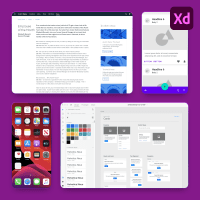
Choosing a framework for your mobile app can feel like choosing between chocolate and vanilla—except the stakes are much higher (and fewer sprinkles). React Native and Flutter have been battling it out for the crown of cross-platform app development, but where do they stand in 2025? Let’s break it down in plain English, with a sprinkle of humor and a whole lot of insight.
React Native and Flutter: A Quick Catch-Up
Before we dive into the nitty-gritty, let’s get reacquainted.
- React Native, backed by Facebook (sorry, Meta), has been around since 2015, making it the seasoned player in the game.
- Flutter, Google’s shiny contender, burst onto the scene in 2018, wooing developers with its sleek UI and strong performance.
Fast forward to 2025, and both have grown up a lot—like your high school classmate who’s suddenly a tech billionaire. React Native has smoothed out its quirks, while Flutter’s ecosystem has exploded, covering everything from mobile to desktop.
Flutter vs React Native Performance: The Tech Behind the Hype
Programming Languages: JavaScript or Dart?
- React Native speaks JavaScript, the language of the web, which you probably already know if you’ve built, well, anything online.
- Flutter uses Dart, a language optimized for UI development, similar to languages like JavaScript and Java in terms of syntax and structure.
Verdict: If you already know JavaScript, React Native feels like a warm hug. If you’re open to learning something new, Dart offers a surprisingly delightful experience.
Performance: Who’s Faster?
- React Native leans on a JavaScript bridge to talk to native components, which can sometimes slow things down (imagine shouting instructions across a crowded room).
- Flutter skips the middleman, using its Skia engine for pixel-perfect performance.
Verdict: Flutter edges out React Native here, especially for apps that need to be lightning-fast.
UI and Design: Who’s Prettier?
- Flutter offers a treasure trove of pre-built widgets that look the same on every platform (consistency is key).
- React Native uses native components, so your app feels more at home on iOS and Android.
Verdict: Flutter’s your best friend for consistent design, while React Native nails the “native” look.
Developer Experience: Smooth Sailing or Choppy Waters?
Development Speed
Both frameworks let you tweak your app and see changes instantly with hot reload.
But Flutter feels a bit more polished, like it’s been to finishing school.
Community Support
- React Native’s been around longer, so its community is massive—like having a million helpful friends.
- Flutter’s catching up fast, thanks to Google’s muscle and a wave of enthusiastic developers.

Where They Shine: Real-Life Examples
Popular Apps Built in React Native
Popular Apps Built in Flutter
React Native powers big names like Instagram, Airbnb, and Walmart. Flutter’s no slouch either, with apps like Google Pay and Alibaba showing off its prowess.
Rule of Thumb: React Native’s great for teams with web developers who want to stick with JavaScript. Flutter shines when you’re aiming for a polished, high-performance app.
The Pros and Cons: Breaking it Down
| Technology | Pros | Cons |
| React Native |
|
|
| Flutter |
|
|
When to Use React Native vs Flutter
When to Use React Native
React Native is ideal if:
- Your team is already familiar with JavaScript, making onboarding smoother and development faster.
- You need your mobile app to have a native look and feel that integrates well with both iOS and Android platforms.
- Your project relies on a wide variety of third-party libraries, as React Native’s ecosystem is more mature.
When to Use Flutter
Flutter is a great choice if:
- You want a highly customizable UI design with pixel-perfect consistency across platforms.
- Performance is a top priority—especially for animations and graphics-heavy apps.
- You’re building for multiple platforms beyond mobile, including web and desktop, and want a unified codebase.

Recent Developments and Features (2023-2025)
React Native
- Improved performance: React Native introduced a new architecture that allows direct communication between JavaScript and native components, improving performance.
- Reduced App Size and start times: Multiple native libraries have been merged to reduce Android app sizes and improve startup times.
- Yoga 3.1 Integration: Improved layout flexibility with support for percentage-based values.
Flutter
- Improved Graphics Performance: Flutter 3.22 Release introduced the experimental Flutter GPU API for enhanced graphics performance.
- Improved Responsive Design: Adaptive and Responsive Design: Expanded guides for creating responsive designs.
- Game Development Support: Added new tools and guides to support cross-platform game development.
The Future of Cross-Platform Development
Looking ahead, both React Native and Flutter are doubling down on multi-platform support. Expect Flutter to push harder into desktop and web, while React Native keeps refining its native integrations.
Pro Tip: If you’re choosing a framework in 2025, think about your team’s skills, your app’s complexity, and your need for speed.
Conclusion: Which is better flutter or react native?
If your team speaks JavaScript fluently and you need something up and running quickly, React Native’s a safe bet. If you want stunning visuals and stellar performance, Flutter might just steal your heart.
At the end of the day, both frameworks are powerful tools—it’s all about what fits your needs best. Now, go forth and build something awesome!
Frequently Asked Questions

Pek Pongpaet
Helping enterprises and startups achieve their goals through product strategy, world-class user experience design, software engineering and app development.
|
Book Free Consultation
-

“Impekable delivered multiple, fantastic options for us… they genuinely cared about the project and our goals.”
Co-founder, JSwipe, acquired by Tinder
Our Case Studies





